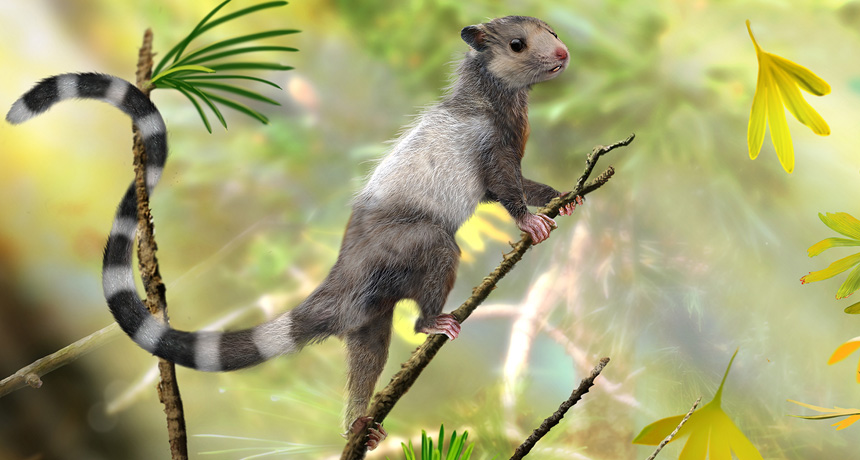Early dino-era start for modern mammals
Fossils suggest earlier origins for the common ancestor of today’s mammals

Looking like a cross between a lemur and a squirrel, the now-extinct haramiyids lived roughly 200 million years ago, a new study finds. The ancient animals, seen here in an artist’s illustration, were ancestors of modern mammals.
ZHAO CHUANG
Share this:
- Share via email (Opens in new window) Email
- Click to share on Facebook (Opens in new window) Facebook
- Click to share on X (Opens in new window) X
- Click to share on Pinterest (Opens in new window) Pinterest
- Click to share on Reddit (Opens in new window) Reddit
- Share to Google Classroom (Opens in new window) Google Classroom
- Click to print (Opens in new window) Print
Scientists recently uncovered the fossil remains of rodent-sized mammals that look like a cross between a lemur and a squirrel. The long-extinct tree-dwellers might have been adorable. More importantly, they could help clear up an old debate about how long mammals have been on Earth. The new fossils suggest mammals first emerged more than 200 million years ago. That’s back in a period known as the Late Triassic. It’s also about when some of the earliest dinosaurs lived.
The new age pushes back the origin of mammals to far earlier than scientists had suspected. How much earlier? Try tens of millions of years.
“This is very exciting stuff,” Robert Asher told Science News. A paleontologist at England’s University of Cambridge, he was not involved with the work. Two hundred million years is “really, really old,” he explains. Scientists had thought mammals first appeared later, during the Jurassic, he says. That’s the period that followed the Triassic.
The new study discovered the remains of unusually ancient mammals called haramiyids (HAIR-ah-MEE-yidz). The first fossils of these animals were unearthed in China more than 100 years ago. Most of those remains were teeth, says Jin Meng. A paleontologist at the American Museum of Natural History in New York City, he worked on the new study. Those teeth didn’t tell much of a story, Meng says. Without more detailed remains, scientists couldn’t determine how the animals might be related to other mammals.
For the longest while, “we just couldn’t find any better material,” he told Science News. “A generation of paleontologists has been looking everywhere.”
Then six new fossils showed up, also in China. They are the most complete skeletons of these animals ever found. They show the animals had skinny tails and long fingers. The shapes of their bodies suggest they were natural tree-climbers. They may even have glided from limb to limb.
The newly identified fossils allowed Meng and his team to probe the history of these animals. These haramiyids belonged to the same large group of animals as modern mammals, the scientists reported September 10 in Nature. That means both haramiyids and modern mammals likely shared a common ancestor. That’s an organism found earlier on the family trees of both animals.
The newfound haramiyid skeletons date back 160 million years. Some previously found teeth date to 200 million years ago. So a common ancestor had to live even earlier, Meng concludes.
The new findings might make some people think differently about ancient mammals, he says. “They were usually considered rat-sized things that lived in the shadow of the dinosaurs,” he says. But “the new evidence shows that mammals were much more diverse than we thought.”
Power Words
evolutionary An adjective that refers to changes that occur within a species over time as it adapts to its environment. Such evolutionary changes usually reflect genetic variation and natural selection, which leave a new type of organism better suited for its environment than its ancestors. The newer type is not necessarily more “advanced,” just better adapted to the conditions in which it developed.
fossil Any preserved remains or traces of ancient life. There are many different types of fossils: The bones and other body parts of dinosaurs are called “body fossils.” Things like footprints are called “trace fossils.” Even specimens of dinosaur poop are fossils.
mammal A warm-blooded animal distinguished by the possession of hair or fur, the secretion of milk by females for feeding the young, and (typically) the bearing of live young.
paleontologist A scientist who specializes in studying fossils, the remains of ancient organisms.
paleontology The branch of science concerned with ancient, fossilized animals and plants.
Triassic Period A time in the distant geologic past, about 200 million to 250 million years ago. It’s best known as the period during which dinosaurs first emerged.







